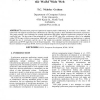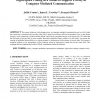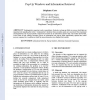INTERACT
1997
14 years 24 days ago
1997
ABSTRACT This paper builds on an existing model of human-computer interaction that focuses on the information structures employed as distributed information resources by users in d...
INTERACT
1997
14 years 24 days ago
1997
In order for global software to be marketed successfully, the design of interfaces should accommodate users’ cultural differences. This study examines users’ culturally specifi...
INTERACT
1997
14 years 24 days ago
1997
Synchronous groupware applications support people collaborating in real time over a distance. The world wide web supports asynchronous collaboration by allowing people to share dis...
INTERACT
1997
14 years 24 days ago
1997
The current solutions to disclosing privacy in computer-mediated communication are two-fold: either the connection is permitted and an audio-video link is opened providing a full-b...
INTERACT
1997
14 years 24 days ago
1997
The tutorial explains the benefits of measuring usability as part of a user-centred design process, and introduces the participants to the methodology for usability measurement dev...
INTERACT
1997
14 years 24 days ago
1997
In Computer Mediated Communication, static video cameras provide a restricted field of view of remote sites. The concept of virtual window has been introduced to alleviate this pro...
INTERACT
1997
14 years 24 days ago
1997
Paralinguistics organizers such as parenthesis, footnotes, and pop-up fields on screen, should play an important role signalling the writer’s “minimization” intention when se...
INTERACT
1997
14 years 24 days ago
1997
The conventional assumption that quality is an attribute of a product is misleading, as the attributes required for quality will depend on how the product is used. Quality of use ...
INTERACT
1997
14 years 24 days ago
1997
Future human-computer interfaces will use more than just graphical output to display information. In this paper we suggest that sound and graphics together can be used to improve i...
INTERACT
1997
14 years 24 days ago
1997
Quick access to short, relevant video segments enables efficient use of a digital video library. This study evaluated an interface designed for such access, an interface that allow...



